Mark Sisson's Blog, page 83
January 28, 2020
23 Easy Keto Snacks
 Our 20 Keto Snacks All Under 5 Minutes has become so popular that we realized that many of you might enjoy a snack or two here and there, whether you identify as intermittent fasters, keto, Primal, Primal-keto, low-carb or other real-food eating ethos. In lieu of fasting when there aren’t any Primal- or keto-friendly food options available and you’re hungry, bringing a snack with you can get you through that long wait at the DMV, the long flight made even longer by delays, or the kids’ football game that went into overtime. Some of the snack ideas we recommend below are pre-packaged (Remember: We’re not anti-convenience here so long as the food inside the package is real and high quality.), and some are quick and easy to whip up on a moment’s notice.
Our 20 Keto Snacks All Under 5 Minutes has become so popular that we realized that many of you might enjoy a snack or two here and there, whether you identify as intermittent fasters, keto, Primal, Primal-keto, low-carb or other real-food eating ethos. In lieu of fasting when there aren’t any Primal- or keto-friendly food options available and you’re hungry, bringing a snack with you can get you through that long wait at the DMV, the long flight made even longer by delays, or the kids’ football game that went into overtime. Some of the snack ideas we recommend below are pre-packaged (Remember: We’re not anti-convenience here so long as the food inside the package is real and high quality.), and some are quick and easy to whip up on a moment’s notice.
Protein-Rich Keto Snacks
1. Teriyaki Meatballs

We love this recipe because it’s just three ingredients, and the meatballs are pre-made. Leftovers make the perfect snack to pop in your mouth, warmed up or cold.
2. Mini Crab Cakes

Pretty and posh for a cocktail party, and easy to dress down for a book club or game-watching snack, these crab cakes can be made with all the veggie and herb fixings, or simplified to a few ingredients.
3. Collard Green Tuna Wrap
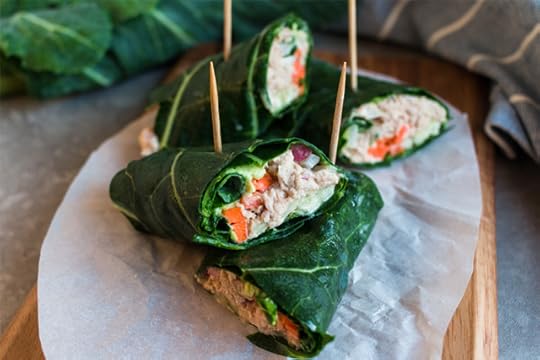
Eat half for a protein- and nutrient-rich snack, or two to three halves for an easy-to-tote lunch. This handheld tuna salad packages protein, veggies, and good-for-you fats in one neat little package.
4. Egg Cups

These muffin-tin egg cups are part omelet, part frittata, and all flexible to suit your individual tastes. Eat two for breakfast, or one for a nutritious snack.
5. Bacon-wrapped Water Chestnuts

Crisp bacon, refreshing water chestnuts, and sweet-salty teriyaki sauce make one showstopper appetizer—or easy-to-make bites to stock in your fridge.
6. BBQ Chicken Skewers

Barbecue chicken never gets old—from pulled chicken cloaked in smoky, salty, sweet sauce to skewered and grilled chicken tenders—this two-ingredient combo provides a satiating snack.
7. Salmon Spread with Nori Chips
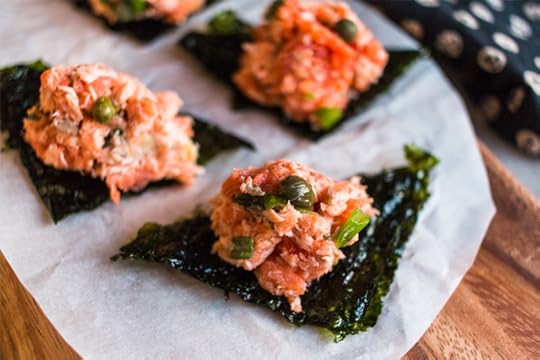
The unctuous flavor and silky mouthfeel of salmon is enhanced with olive oil and butter, then spooned onto brittle, briny nori chips for a Primal spin on rice-free sushi.
8. Caprese Salad Skewers

This salad and antipasto platter on a stick coats the tongue with the fatty richness of salami, soft creaminess of fresh mozzarella, sweet and juicy burst of tomato, and the palate-cleansing crunch of bibb lettuce. Dip in Primal Kitchen Italian Dressing for extra herby vinaigrette flavor.
9. Collagen Gummies

For a shot (or two) of collagen peptides, these collagen gummies provide a fun-to-eat way to get more protein. Stash them in a reusable bag or container in your gym bag, or bring them to work for an afternoon snack.
The Best Packaged Keto Snacks
10. Bone Broth

Salty, thick, and welcome on a chilly day, bone broth purchased online or from the store can be dressed up with herbs and aromatics, if desired, for a sippable or spoonable snack.
11. Primal Kitchen® Protein Bars
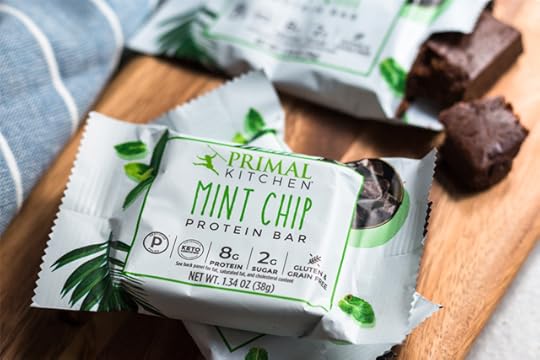
These four-bite squares deliver protein and healthy fats in the form of real-food ingredients like almonds, eggs, and flaxseed.
12. Keto-friendly Jerky

Chewy, salty, and portable, jerky without additives and sugars makes an entirely Primal and keto-friendly option.
13. Pork Rinds

Crackly, salty crisped pork skin… we’re just going to leave this recommendation right here.
14. Primal Kitchen Keto Collagen Lattes

These new tea lattes combine collagen with coconut milk powder and vanilla extract to make creamy, caffeinated ways to enjoy collagen peptides.
Sweet Keto Snacks
15. Keto Donut Holes

Redolent of cake donut holes, these two-bite treats combine macadamia butter with collagen and monk fruit to make irresistible sweets.
16. Chocolate Bacon
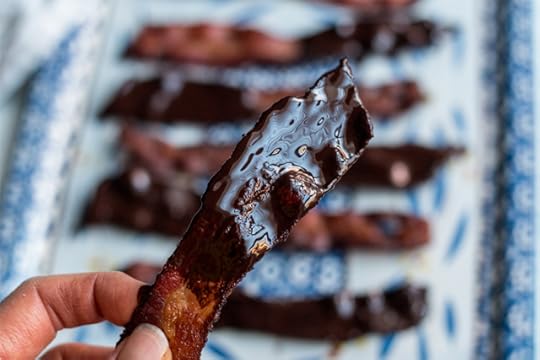
Dark chocolate and smoky bacon… do we have your attention? Dip crisped bacon in melted dark chocolate and try not to drool.
17. Keto Trail Mix

Who knew that three simple ingredients could combine to invoke a ballet on the tongue? Combine (salted or unsalted) macadamia nuts with dark chocolate and unsweetened coconut chips. Attempt to ration your portions.
18. Mark’s Vanilla Collagen Hemp Latte

Born from a desire for an epicurean way to boost magnesium, Mark added hemp hearts to his vanilla collagen latte. This warm, cinnamon-flecked brew can be concocted and enjoyed warm or refrigerated overnight to sip cold the next day.
Plant-Based, Vegetarian Keto Snacks
19. Nut Butter on Celery Sticks

Remember ants on a log: peanut butter-slathered celery boats dotted with raisins? Make a grown-up version by ditching the raisins and peanut butter with added sugar.
20. Keto Mozzarella Sticks
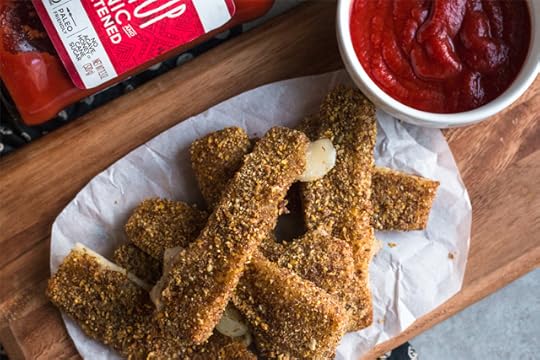
To make a keto-friendly version of this favorite bar snack, whisk an egg and dip mozzarella cheese (cut into 4-inch logs) into the egg. Coat the egg-dipped cheese logs in almond flour and place on a baking sheet. Turn your oven to broil (500ºF); bake mozzarella sticks for three minutes, or until golden brown.
21. Mini Bell Peppers with Cream Cheese

Sweet and crunchy, baby bell peppers make the perfect cups for a spoonful of cream cheese and a sprinkle of chopped chives.
22. Onion Petal with Melted Cheddar

Sharp and pungent, red onion mellows a bit when placed under the broiler for a minute. Top red onion petals with generous cuts of cheddar cheese, then place under the broiler for 30 to 40 seconds, or until the cheese melts.
23. Snap Peas with Primal Kitchen Ranch Dressing

Herb-studded, creamy, tangy Primal Kitchen Ranch Dressing upgrades any snappy veggie.
Photographs by Priscilla Chamessian, Janee Meadows, and Kali Meadows.
The post 23 Easy Keto Snacks appeared first on Mark's Daily Apple.



January 27, 2020
Dear Mark: OMAD for Women, Low-Carb Glucose Testing, and Carb Limit When Fasting
 For today’s edition of Dear Mark, I’m answering three questions taken from last week’s post on the power of pairing low-carb with fasting. First, do I have any advice for a woman who’s struggling to see results eating one meal a day? Second, how does low-carb interact with the different types of glucose tests you can take? And third, what are my thoughts on carb limits when fasting? Is lower always better? Is there a carb threshold after which fasting stops working so well?
For today’s edition of Dear Mark, I’m answering three questions taken from last week’s post on the power of pairing low-carb with fasting. First, do I have any advice for a woman who’s struggling to see results eating one meal a day? Second, how does low-carb interact with the different types of glucose tests you can take? And third, what are my thoughts on carb limits when fasting? Is lower always better? Is there a carb threshold after which fasting stops working so well?
Let’s go:
I have been dappling in low carb for nearly year and in the last 2-3 months I have been playing around with OMAD. My question is, I eat ’till I’m full ,which is about 12-18 grams of carbs, never over 100g protein and around 100g fat, sitting at 1000-1400 calories—but I’m not losing weight. Over 3 months I’ve lost about 6kg and I have about 30kg to lose. Do I keep going? I’m enjoying it but I get frustrated about the lack of weight loss (I’ve lost a dress size).
The majority of women don’t do well on one meal a day. Consider the average office worker struggling to lose weight. They do coffee for breakfast and maybe have a salad with no meat (and few calories) for lunch, struggle mightily not to eat five stale donuts at 3p.m. in the break room, only to cave at night and eat a sack of potato chips and take out while streaming some show.
My point is not that these people would do better if only they ate a solid meal for dinner rather than chips and snacks and Netflix. Nor is it that this problem only afflicts women and never men. Plenty of men do it, too, and have bad results. But it shows more quickly in women, who by nature of their reproductive physiology are simply more vulnerable to nutritional insults than men—on average. I explain the reasons this happens in this post on fasting for women. Long story short, because reproduction is far more costly and demanding on a woman’s body than a man’s (conception, pregnancy, nursing); woman are more finely attuned to caloric restriction and fasting. My point is that fasting for most of the day, every day, doesn’t work well for most women—it becomes a constant stressor, driving unhealthy cravings to which you eventually succumb.
It sounds like OMAD might not be working for you. Just one dress size (which is a better barometer than weight) in 3 months? Yeah, it might be time to try something else.
Was low carb with more frequent meals working?
I’ve seen a lot of men burn out on OMAD, too. Throw in some sleep disturbances, a heavy training schedule, work-related stress, cooking for the family, bills, and whatever other stressors modern life throws our way, and OMAD can be counterproductive.
For one thing, your calorie intake is way too low. One thousand calories is way too low; 1400 calories is really pushing it. Perpetually starving yourself for 22 hours a day and then trying to cram a big meal in that doesn’t even provide enough calories or nutrients just doesn’t work for most people. I can imagine your leptin is low, your caloric expenditure dampened, your thyroid function inhibited.
Here’s what you might try.
Do OMAD with 1000-1400 calories once a week. Twice max. Eat normal—two to three meals—the rest of the days. This way you pulse your fasting and OMAD’ing. You eat normal amounts of calories for five days a week and then drop them down low twice a week, giving your body a message of relative abundance punctuated with short bouts of scarcity.
I think that’ll work better for you. Write back with your results.
If you are low carb and need to do a glucose blood test and an A1C test: What is the best fasting times then? Just the night before or for 24 hours?
If you fast longer, shouldn’t the glucose reading be lower?
It really depends on what kind of test you take.
If you’re doing a fasting blood glucose test, fasting will probably lower it.
If you’re doing a postprandial blood glucose test, fasting will probably raise it. You’re asking your body to suddenly go from burning fat to processing 75 grams of pure glucose. The fat-based metabolism triggers transient insulin resistance, which inhibits your ability to process the glucose efficiently. Your postprandial reading will thus be higher than is “real.”
If you’re doing an HbA1c test, fasting won’t affect it. HbA1c is the “average” blood sugar over three months or so; a single meal will have no impact.
I totally agree with the science of this relationship. Mark, at what intake level of carbs are you considering this relationship no longer synergistic? Anything over 100 grams or should the carb intake be kept lower to have the greatest fat-burning / weight-loss effect?
The bulk of the synergy lies in the ease with which you can maintain the fast. Low-carb/fat-based metabolisms simply make it easier to slip into and remain in the fat-based metabolism of the fasting state. If you can easily fast, easily slip back into ketosis and maintain the fast while eating an otherwise moderate or high-carb diet, have at it. That isn’t as common as the opposite, drawing on my experience talking to hundreds of people about this.
However, some people get the best weight-loss effect by combining intermittent fasting, heavy weight training, and periodic/timed carb feeds. The trick is to time your carbs around your workouts, and eat no more than you’ve actually expended through glycogen depletion. That means you’re still in a fat-based metabolism because the carbs you do eat are going toward glycogen repletion rather than being burned for energy, so they never actually inhibit the burning of body fat.
If you’re doing CrossFit WODs that hit every muscle and leave you panting on the ground (or the equivalent), you could probably get away with 100-200 grams right after without any issues. It really depends, of course. More muscle, larger glycogen sinks. Some people just slip right back into ketosis more easily. Others have a life history that may inhibit this. But that 100-ish carbs after a “hard” training session that you feel should be a good target for most people.
You should keep fat low and protein high in these carb-heavy meals. What you want is to refill that glycogen and hit the protein hard.
That’s it for today, folks. Take care. Be sure to ask any followups or additional questions down below. Thanks for reading!
The post Dear Mark: OMAD for Women, Low-Carb Glucose Testing, and Carb Limit When Fasting appeared first on Mark's Daily Apple.



January 25, 2020
Mini Keto and Primal Crab Cakes
 Crab cakes may remind you of cocktail parties, weddings, or sun-soaked getaways to the seashore where you seek refuge from the sun at a fish shack that serves only the freshest local seafood. Most traditional crab cake recipes include breadcrumbs or flour (or both) and are deep fried in vegetable oil so the end result is a greasy, bready puck that disrespects the naturally sweet, succulent essence of lump crabmeat. We remade the classic crab cake to make it Primal and keto-friendly. Don’t be put off by the long list of ingredients; we like the way the vegetables and seasonings accentuate the crab, but if you prefer a pared-down version, the crab, almond flour, herbs, mayo, egg, lemon juice, salt and pepper would make a perfectly lovely crab cake, too.
Crab cakes may remind you of cocktail parties, weddings, or sun-soaked getaways to the seashore where you seek refuge from the sun at a fish shack that serves only the freshest local seafood. Most traditional crab cake recipes include breadcrumbs or flour (or both) and are deep fried in vegetable oil so the end result is a greasy, bready puck that disrespects the naturally sweet, succulent essence of lump crabmeat. We remade the classic crab cake to make it Primal and keto-friendly. Don’t be put off by the long list of ingredients; we like the way the vegetables and seasonings accentuate the crab, but if you prefer a pared-down version, the crab, almond flour, herbs, mayo, egg, lemon juice, salt and pepper would make a perfectly lovely crab cake, too.
Mini Keto & Primal Crab Cakes
Ingredients

8 oz. lump crabmeat
2/3 cup almond flour
1/3 cup parsley, chopped
1/3 cup celery, chopped
1/4 cup dill, chopped
1/4 cup carrot, chopped
1/4 cup red onion, minced
1/4 tsp. salt
1/4 tsp. black pepper
1/4 tsp. paprika
2 1/2 Tbsp. Primal Kitchen Mayo
1 tsp. dijon mustard
1/2 tsp. lemon juice
1 egg
2 Tbsp. Primal Kitchen Extra Virgin Olive Oil or Avocado Oil
Instructions
Preheat oven to 350ºF. Squeeze out any excess liquid from the crabmeat.

Combine the crabmeat, almond flour, parsley, celery, dill, carrot, onion, salt, pepper, and paprika in a bowl. Mix in the mayo, mustard and lemon juice. Whisk the egg and mix it in with the crab mixture.
Form 16 small crab cake balls from the mixture.

Heat the oil in an oven-safe pan over medium heat. Once hot, add the crab cakes to the pan and sear for 1-2 minutes. Carefully flip the crab cakes over and sear for an additional 1-2 minutes. Transfer the pan to the oven for about 15 minutes, or until the crab cakes are firm.
Allow them to cool slightly before removing them from the pan. Insert toothpicks and arrange them on a platter. Create a quick dipping sauce by mixing your favorite Primal Kitchen Mayo with a little lemon juice and paprika.

Nutrition Information per serving (per crab cake):
Calories: 83
Total Carbs: 2 grams
Net Carbs: 1 gram
Fat: 7 grams
Protein: 24 grams
The post Mini Keto and Primal Crab Cakes appeared first on Mark's Daily Apple.



January 24, 2020
Weekly Link Love – Edition 65

Research of the Week
Blue-blocking glasses improve mania patients’ sleep quality.
The human landscape of ancient Africa looked a lot different 3000 years ago.
Without changing caloric intake, time-restricted eating improves metabolic health.
Ramadan-style fasting (30 days of 14-hour fasts, from dawn to sunset) activates proteins related to cancer protection, glucose regulation, fat burning, cognitive function, and immune function.
In Danes, taking fish oil was associated with larger testicles and better sperm parameters.
Women who take the birth control pill tend to have smaller hypothalamuses.
Grass-fed beef is darker, firmer, and less acidic than grain-fed beef.
New Primal Blueprint Podcasts
Episode 400: Dr. Corey Riser: Host Elle Russ chats with Chiropractor and Certified Functional Medicine Practitioner Dr. Corey Riser.
Primal Health Coach Radio, Episode 44: Laura and Erin chat with Anya Perry and Deanna Wilcox, founders of Plan to Succeed.
Each week, select Mark’s Daily Apple blog posts are prepared as Primal Blueprint Podcasts. Need to catch up on reading, but don’t have the time? Prefer to listen to articles while on the go? Check out the new blog post podcasts, and subscribe to the Primal Blueprint Podcast here so you never miss an episode.
Media, Schmedia
California may call Tylenol a carcinogen.
American Southerners in particular are inactive (but everyone’s pretty bad).
Interesting Blog Posts
Fat from your last meal sets the metabolic table.
Dr. Danenberg goes carnivore for his cancer.
The glucose-lowering effect of ketones.
Social Notes
Amy Remondi explains how she learned the science of Primal health and fitness while building her business.
Play a little. Or a lot.
Everything Else
What the smartphone has done to our concept of “space.”
More calls to look into the ethics of Harvard’s meat science research.
Things I’m Up to and Interested In
Interesting stat: When trying to lose weight, female doctors tend to personally use intermittent fasting, ketogenic diets, and low-carb diets.
Question I found interesting: What’s driving people to seek out and relish objectively painful and uncomfortable stimuli like cold water swimming?
I agree with this principle: Happiness (and love) is what matters.
Why not both?: Exercise as a caffeine alternative.
One of many: The forgotten art of squatting.
Question I’m Asking
Are you worried about the coronavirus?
Recipe Corner
Make this: tonnato sauce.
Crunchy chicken salad.
Time Capsule
One year ago (Jan 18– Jan 24)
Is Iron the New Cholesterol? – Well, is it?
Explaining Keto and Hair Loss (and Why Any Dietary Change Might Cause It) – Is keto to blame?
Comment of the Week
“Years ago my brother was placed on a drug for high blood pressure. Within two weeks he had a heated disagreement with his neighbor and code enforcement at his home that led to a SWAT team being called. Fortunately one of his neighbors was a cop in the same city; he was able to de-escalate the situation and no one was harmed. The next day my brother realized his outrage about many things had begun after taking the drug. He discontinued it. Three years later his wife was put on the same drug; due to constant arguing, they ended up divorced. They had been high school sweethearts.”
– That’s a sad, alarming story, Lisa.

The post Weekly Link Love – Edition 65 appeared first on Mark's Daily Apple.



January 23, 2020
Learn Proper Running Form to Increase Efficiency and Decrease Injury Risk
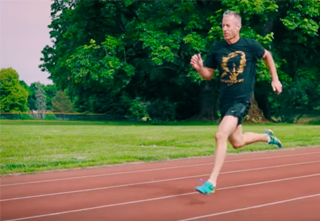 Running is the most simple and straightforward of fitness activities, so we generally don’t pay much attention to learning and refining proper running form. Consequently, there’s a widespread problem of joggers and runners with extremely inefficient technique that can lead to slower times and increased risk for injury.
Running is the most simple and straightforward of fitness activities, so we generally don’t pay much attention to learning and refining proper running form. Consequently, there’s a widespread problem of joggers and runners with extremely inefficient technique that can lead to slower times and increased risk for injury.
Unfortunately, when you plod along at a jogging pace, the penalty for inefficient running form and lack of explosiveness is minimal. In contrast, when you sprint, you try to generate maximum explosive force with each footstrike, so even the slightest technique inefficiency or wasted motion delivers a severe performance penalty. Sprinting, Primal Blueprint Law #5, is a great way to clean up technique errors and drift in the direction of proper running form.
Read More: See The Definitive Guide to Sprinting, Part 1, and The Definitive Guide to Sprinting, Part 2 for everything you need to know about sprinting.
Here, we’ll break down the components of proper running form. If you struggle with some of the technical explanations, watch the technique instruction video to help you grasp the concepts.
The Fundamentals of Proper Running Form
The basics of proper running form are pretty simple: Your body should be in stable position with your center of gravity balanced over your feet at all times. The classic image you see on trophies or in clip art of a runner with legs extended way behind or in front of the body represent egregious technique errors.
Instead, check out this slow motion video of the greatest sprinter of all-time, Usain Bolt. Wait until the sprinters get up to speed and are standing tall, then notice how Bolt and the other sprinters preserve straight and elongated spines at all times. Their feet land right underneath their bodies with every stride. The sprinters never lurch forward unless they’re diving for the finish line tape!
Proper Running Form: Like Riding a Bike?
The illusion that you must run forward—extending your legs or torso forward to cover ground—leads to overstriding at all speeds. If you alter the position of your torso relative to your moving legs, you’ll have a significant energy cost to recalibrate for the next stride.
Instead of trying to cover huge chunks of ground with forward-lurching efforts, envision running like you pedal a bicycle: Your upper body is upright and stationary (like sitting upward on the bike seat); feet cranking the pedals in a smooth circle, then feet returning to the same position under the seat with every revolution.
For the most efficient energy transfer on each stride, focus on getting your feet onto the ground and off the ground as fast as possible—as you would to pedal a bike faster. You can also strive to run like a deer or a canine companion, who exhibit a stable center of gravity (albeit over four legs, not two), incredible explosiveness off the ground, and zero wasted energy.
?
3 Common Running Form Mistakes
The biggest issues I see that disrupt proper running form:
Upper body instability: Leads to unecessary side-to-side motion of the torso, arms, and pelvis
Destabilized core: Leads to overstriding
“Lazy feet”: You land and sink into the ground instead of exploding off of it
When you implement proper running form, you’ll feel lighter on your feet and more explosive right away. Let’s cover each of the fundamentals of proper running form so you can begin striding like a beautiful deer.
How to Correct Upper Body Instability
When your spine compresses and your neck retracts toward the shoulders during running, you lose kinetic energy, promote inefficient breathing, and instigate a fight-or-flight activation. Dr. Kelly Starrett, creator of The Ready State, author of the bestselling injury prevention and rehab masterpiece, Becoming A Supple Leopard, and all-around legend of the elite athletic performance scene, explains:
“We’ve seen up to a 30 percent decline in VO2 max due to compromised breathing and a misaligned load anywhere along the spine. When runners fatigue, they become destabilized. The pelvis gets overextended and their man-bellies hang out. Mechanically, the nervous system becomes compromised and unable to generate maximum force, or transfer energy into the ground. Furthermore, when the 11-pound head is destabilized and the neck is destabilized, the athlete defaults into a shallow, ‘stress-breathing’ pattern. This over activates the sympathetic nervous system—the fight-or-flight response—and makes workouts more stressful than they should be, and more difficult to recover from.”
Hold your head high and onward we go! To correct upper body instability while running:
Keep the torso and head quiet and tension-free at all times. Pay special attention to keeping the cervical spine elongated.
Keep the hips and shoulders forward-facing. Don’t swivel or rotate from side to side, and don’t rock the pelvis forward and backward.
The only energy output from your upper body should be to pump your arms for momentum. The faster you run, the more energy you’ll exert to pump the arms. At jogging speed, you essentially relax your arms and achieve a gentle, natural counterbalance swinging of the arms to help balance the swinging of the legs. When you sprint, you drive the arms forward and backward powerfully.
Regardless of running speed, you don’t want your shoulders to lurch forward, nor should any part of your arms or hands cross the centerline of your body. Envision your arms pumping back and forth in one plane like a locomotive engine or oil well.
All the energy for arm swinging should come from the larger muscles in the shoulders, while your hands, forearms, and upper arms should be completely relaxed instead of tense. Sprinters make a point of extending the fingers to prevent a natural inclination to make a fist and tense the forearms. For the arm swing, pick an angle, such as 90 degrees, and preserve that angle throughout the arm swing. Avoid the common error of straightening your arm on the backswing, as this results in a loss of energy backwards.
How to Correct a Destabilized Core
While we emphasize relaxation instead of tension, realize that you need to generate explosive forward propulsion from your extremities from a stable base—your core and pelvis area. Again, the urgency of keeping your core and hips stable instead of loosey goosey is minimal while jogging, but extreme while sprinting.
Correcting a destabilized core seems simple, conceptually:
Make a concerted effort to slightly engage the core muscles throughout the stride pattern, especially at impact, and especially as you start to run faster.
This will preserve that straight and elongated spine as well as prevent the disastrous error of energy collapsing into the ground. This energy collapse is quite common and can cause the hips to become un-level upon each stride impact. Remind yourself to engage your core muscles—pull in those abdominal muscles—as you run. This will also help keep your spine elongated and your neck straight.
How to Correct “Lazy Feet” or Shuffling
To maximize explosiveness and minimize energy loss on each stride:
Dorsiflex the foot as soon as you launch off the ground. Aggressively flex the ankle and foot upward as high as you can (up to 30 degrees, toward the shin) as soon as your foot leaves the ground.
Through the stride pattern prior to the next impact, point the toes forward with the sole nearly parallel to the ground. This achieves an energy coiling effect in preparation for the next footstrike, where you’ll transfer that energy onto and off of the ground ground as quickly as possible.
You can also visualize the instructions above in the context of pedaling a bike. Pushing the pedal forward requires dorsiflexion of each foot in order to keep your feet on the pedals while completing the circle.
The opposite of dorsiflexed feet: lazy feet, which occurs when one leg leaves the ground and that foot remains relaxed in a drag through the air, toes pointed toward the ground.
When that uncoiled foot hits the ground on the next stride, there is no kinetic energy to leverage. The foot lands, spends much more time on the ground than a spring-loaded foot would, and the impact of your entire bodyweight transfers onto the pavement or trail. Then you recover from the impact, summon a bit of force, and get your foot off the ground again. This practice wastes potential explosive energy that could be returned by consciously (at first) dorsiflexing the foot.
?
Watch the clip above to see the slow motion of lazy foot. Look carefully and you’ll notice a barely perceptible collapsing of energy into the ground, even on that very slow jogging stride. Due to the energy collapse, the foot spends more time on the ground than it does with a quick stride generated by “strong foot” running.
Pretend that your running surface is hot lava. As soon as your dorsiflexed foot hits the ground, explode off the ground before you get burned. “On the ground, off the ground” is a great mantra as you move at any running speed. While a sprinter drives the knees high into the air, exploding off the ground and taking long strides accordingly, a jogger makes smaller circles and takes shorter strides. Nothing changes in your running form as you speed up except you take longer, more explosive strides.
?
Watch the clip above to see how my technique looks the same at a variety of speeds.
Every time you jog, run, or sprint, strive to achieve the bicycling over hot lava technique and you will soon ingrain the “strong foot” running form to the extent that it will feel terrible to jog with lazy feet. Good luck and enjoy a more graceful and explosive running experience.
Have you tried these or other running form corrections with success? What’s worked and what still feels difficult? Share in the comments below.
Tremendous credit and appreciation for these lessons goes to retired U.S. Olympic team 1500-meter runner Michael Stember, who presented his running technique clinic several times at our PrimalCon retreats in Oxnard, CA. Michael captivated the crowd each time with an incredibly passionate and precise clinic on how to run properly. Now he does the same making sushi in Brooklyn, NY.
Recommended Related Reading and Videos:
Primal Blueprint Law #5: Sprint Once in a While
The Definitive Guide to Sprinting, Part 1
The Definitive Guide to Sprinting, Part 2
More scientific discussion and technique breakdown from the great Michael Johnson, former world record-holder in the 200 and 400 meters
How to Cure Plantar Fasciitis
Plantar Fasciitis: Best Shoe Choices
The post Learn Proper Running Form to Increase Efficiency and Decrease Injury Risk appeared first on Mark's Daily Apple.



January 22, 2020
Benefits of Pairing Low-Carb Eating with Intermittent Fasting for Health and Weight Loss
 Most of the low-carbers I know end up experimenting with intermittent fasting at some point in their journey, and most of the IFers I know end up drifting toward low-carb eating as time wears on.
Most of the low-carbers I know end up experimenting with intermittent fasting at some point in their journey, and most of the IFers I know end up drifting toward low-carb eating as time wears on.
Why?
Is it just a case of overlapping interests? Is it because when you stumble upon one big lie perpetrated by the experts—that cutting carbs will give you heart disease and leave your brain starving for energy/you must eat 6-8 small meals a day or else risk “starvation mode” and “slow metabolism”—you start questioning all the other advice they give?
It might be some of that. But a big reason why intermittent fasting and low-carb eating tend to converge is that they are synergistic. Doing one makes the other work better, and vice versa.
What are the benefits? What are the synergies?
Fasting is easier when you’re low-carb. Low-carb is easier when you fast.
Low-carb is easier when you fast.
Fasting is easier when you’re low-carb.
The two inputs support each other. Rather than a vicious cycle, it’s a virtuous one. Fasting promotes fat-adaptation by upregulating fat-burning mitochondria, spurring the creation of new mitochondria, and reducing your reliance on sugar. Fat-adaptation makes going low-carb easier, because you’re really good at burning body fat and don’t get so many sugar cravings. Going low-carb makes you even better at burning fat and builds even more mitochondria, which is a prerequisite for fasting for extended periods of time.
If low-carb is going to work, you have to do it. If fasting is going to work, you have to fast. Anything that makes those easier is going to be good for your health. That’s where it all starts.
You’ll burn more fat.
A 2013 study compared low-fat dieters on an alternate day fasting schedule with low-carb dieters on an alternate day fasting schedule. Both groups lost weight and improved metabolic health markers, but the low-carbers lost more body fat.
A more recent study putting low-carbers on a fasting schedule for six months saw their body fat drop, lean mass remain stable, and fasting insulin decrease. However, there was no control group and the low-carb diet was still 30% carbs. I think you’d see better results if you dropped those carbs down even lower.
You’ll lose less muscle.
One common criticism lobbed at intermittent fasting enthusiasts is that it has the potential to cause muscle loss. This is a valid point. If you are insufficiently fat-adapted, your glucose requirements will remain elevated when fasting, and you may break down muscle tissue for the amino acids to convert to glucose.
Luckily, ketones spare muscle tissue by reducing your need for glucose. It turns out that a fair number of tissues that would otherwise run on glucose can run on ketones. Being in a ketogenic or low-carb fat-burning state before you fast accentuates this effect. It’s no wonder that the studies mentioned in the last section found that weight loss via low-carb dieting and fasting was entirely from body fat.
Bump up the muscle-sparing effect even more by lifting heavy things (even during the fast).
You’ll forget to eat.
A major reason low-carb and keto diets work so well for weight loss is that they increase satiety and inadvertently reduce calories. Whereas your average calorie-counter is painstakingly tracking everything he or she eats and expends just to wrangle a few pounds lost, the low-carb dieter often just eats to satiety and lets the weight loss happen.
The average low-carber will fast without even thinking about it. They fast because they simply aren’t hungry and forget to eat. Someone on a higher-carb “regular” diet often must summon superhuman willpower to fast. They fast in spite of being ravenous and can think of nothing else but eating.
Forgetting to eat is a much easier way to fast than willing yourself to do it.
You’ll avoid harmful postprandial blood sugar spikes.
Eating a high-carb meal after fasting for two days will spike your postprandial blood sugar. Eating a low-carb meal after fasting for two days will likely not. Why?
Consider the problem of the long-term low-carber trying to pass a glucose tolerance test. It’s common for long-term low-carbers to “fail” glucose tolerance tests because they’re trying to handle 75 grams of pure glucose with a fat-based metabolism. The body is set up to burn fat and you suddenly introduce a bunch of glucose. It’s hard to do, and most people will fail that—even if they’re healthy.
When you’re coming off a fast, you’re burning fat. You may not have the glucose intolerance of a long-term low-carber, but you are running on fat, and that’s going to raise the chance of exaggerated postprandial blood sugar numbers.
If you do want to eat carbs after a fast, the best way to mitigate this issue is to break the fast with a hard workout and then eat the carbs. You’ll “simulate” glucose tolerance by clearing out glycogen and providing open storage depots for the incoming carbohydrates.
Or you could just be a low-carber to begin with and avoid the problem altogether.
You’re less likely to overdo the re-feeds.
Fasting is a great way to induce caloric deficits and thus lose weight. That’s pretty much why it works so well, as an artificial boundary to control our eating and snacking habits. However, people can tend to go a little wild on the re-feeds. They haven’t eaten all day, so of course they’re going to pig out when they break the fast and eat all sorts of foods they wouldn’t otherwise eat—and eat way more calories than they would have, thereby counteracting all the good they did not eating.
If you’re sticking to low-carb or keto principles, the re-feed is safer. You’re less likely to overeat, because low-carb is so satiating. You’re less likely to eat junk, because the “rules” of the diet eliminate most of the offending foods like chips, sweets, and fried carbohydrates.
Your insulin will normalize.
When insulin is elevated, fat is locked away in our adipose tissue, making it very difficult to burn fat. Hyperinsulinemia, or chronically elevated insulin, also increases the risk of cancer and Alzheimer’s disease, and elevated insulin levels are linked to atherosclerosis.
Intermittent fasting is a potent antidote to hyperinsulinemia. This recent study found that, despite causing similar reductions in body weight, alternate day fasting led to greater improvements in insulin and insulin resistance than regular caloric restriction.
Low-carb eating is also a potent antidote to hyperinsulinemia. As it turns out, avoiding carbohydrates reduces one’s insulin load.
I’m no enemy of insulin. It serves many valuable purposes, and we wouldn’t be alive without it. But too much insulin at the wrong time causes undeniable problems—and combining IF with low-carb can normalize it.
So, should you avoid fasting if you’re not low-carb?
Not necessarily.
Fasting while low-carb isn’t the only way to do it. Many people have great success combining high-carb dieting with fasting, provided they also lift weights. One popular (and effective) method is to go high-carb, low-fat on training days, with the workout coming at the tail end of the fast and the first meal coming after the workout. Then on rest days, you break the fast with low-carb, high-fat meals. The training stimulus increases insulin sensitivity and gives all those carbs a place to go (your muscle glycogen stores).
But combining low-carb and intermittent fasting really does increase and accentuate the benefits of both practices.
Thanks for reading, everyone. I’d love to hear about your experiences with intermittent fasting and low-carb eating. Do you find that the two go hand in hand, or have you also had success fasting with a higher-carb diet?
References
Klempel MC, Kroeger CM, Varady KA. Alternate day fasting (ADF) with a high-fat diet produces similar weight loss and cardio-protection as ADF with a low-fat diet. Metab Clin Exp. 2013;62(1):137-43.
Kalam F, Gabel K, Cienfuegos S, et al. Alternate day fasting combined with a low-carbohydrate diet for weight loss, weight maintenance, and metabolic disease risk reduction. Obes Sci Pract. 2019;5(6):531-539.
Mujaj B, Bos D, Kavousi M, et al. Serum insulin levels are associated with vulnerable plaque components in the carotid artery: the Rotterdam Study. Eur J Endocrinol. 2020;
Gabel K, Kroeger CM, Trepanowski JF, et al. Differential Effects of Alternate-Day Fasting Versus Daily Calorie Restriction on Insulin Resistance. Obesity (Silver Spring). 2019;27(9):1443-1450.
The post Benefits of Pairing Low-Carb Eating with Intermittent Fasting for Health and Weight Loss appeared first on Mark's Daily Apple.



January 21, 2020
6 Concrete Ways to Rewire Your Brain for Successful Habit Change
 We all know the grim stats about how many New Year’s resolutions fail. It’s not because making resolutions is hokey or people are inherently lazy. It’s because most resolutions come down to one of two things: adopting new (good) habits or breaking old (bad) habits, and habit change is hard.
We all know the grim stats about how many New Year’s resolutions fail. It’s not because making resolutions is hokey or people are inherently lazy. It’s because most resolutions come down to one of two things: adopting new (good) habits or breaking old (bad) habits, and habit change is hard.
People struggle at every step, from picking the right goals—ones that are motivating and achievable—through the implementation process.
The trick is to be strategic and intentional about changing your habits. Rather than relying on willpower and wishes, get good systems in place. As James Clear, author of Atomic Habits, says, “You do not rise to the level of your goals. You fall to the level of your systems.”
What Are Habits, and How Do You Change Them?
Successful habit change is the process of taking a behavior that currently requires cognitive effort and making it automatic.
“Automatic” is a word psychologists use to describe behaviors that don’t require a lot of cognitive attention or processing. Habits are any behaviors that have become automatic: walking past the cereal aisle at the store instead of turning down it, swinging your legs out of bed when your alarm goes off, going to yoga class on your lunch break.
Adopting new habits might feel difficult at first, but with enough repetition they feel easy, like you’re not even thinking about them. That’s sort of true. Effortful behavior relies on the prefrontal cortex, the higher-level thinking and planning part of your brain. Habitual behavior is governed by a different structure called the basal ganglia.
From a cognitive perspective, this is highly advantageous. The brain has a massive number of inputs to deal with each day. The more behaviors we don’t have to think much about, the better.
So if building habits is so desirable for the brain, why isn’t it easier?
How Habit Change Works
On a basic level, all behavior works like this:
Cue (trigger) –> Response (behavior, action) –> Feedback (consequences)
To make a behavior a habit, the feedback has to be rewarding. You also have to repeat the behavior over and over to reinforce the relationship between cue and response:
Cue (trigger) –> Response (behavior, action) –> Reward –> Repeat
It’s elegantly simple but obviously not easy. The process can break down at any point along the way. The good news is you can improve your odds of success by beefing up any part of the system—the cue, the reward, or the “in-between stuff” represented by the arrows.
You don’t necessarily need to do all of these for each new habit you’re trying to build. One might be enough. On the other hand, this is often a more-is-better situation.
Target #1: Strengthen the Cue
A cue can be a time of day (first thing in the morning), something you see or do in your environment (opening the fridge, watching a TV commercial), or a feeling (tension in your neck, boredom).
In order to build a reliable habit, number one: make the cue stronger. In the language of Atomic Habits, make it obvious.
Targets #2, 3, and 4: Mind the Gap
A lot happens in the space between noticing the cue and initiating the behavior. According to Dr. Steve Wendel’s behavior funnel, this includes:
Gut reaction – your initial “yay” or “ick” feeling about the behavior that’s being cued
Evaluation – your more thoughtful evaluation of the cost and benefits of doing the behavior
Ability and timing checks – deciding whether you have the resources to follow through and whether there is any sense of urgency
Thus, to increase the likelihood of making it to the response phase, you can:
Number two: Make it more appealing (“Make it attractive,” says James Clear.)
Number three: Make it feel more feasible (increase your ability)
Number four: Make it urgent
Target #5: Make It Rewarding
While developing better habits can be rewarding in and of itself, you can speed the process along by building in positive reinforcement. Especially if your goal is long-term (weight loss, training for a marathon), more immediate rewards can be helpful.
Target #6: Rinse, Repeat
To really ingrain the habit, you have to do the behavior over and over. The more you do, the stronger the cognitive association between the cue and the behavior and, over time, the more automatic it becomes.
The Process in Action
Let’s say you’ve decided to start going to the gym after work twice per week to lift weights. Here are 20 things you can do to increase your chances of success.
Strengthen the Cue
1. Leave yourself reminders.
Put post-it notes on your bathroom mirror, fridge, or laptop.
Set alarms on your phone.
2. Arrange your environment.
Keep your gym bag on your front seat.
Put your exercise tracking app on the home screen of your phone.
3. Use implementation intentions. This a fancy way of saying “make a plan.” Be specific. Use if/then statements. Research has shown that implementation intentions are incredibly powerful tools for instilling new habits.
“I will go to the gym on Mondays and Thursdays at 5:30 p.m.”
“When I leave the office, I will head straight to the gym.”
“If the gym is crowded when I get there, I will adjust my workout instead of leaving.”
4. Use habit stacking, a specific type of implementation intention. Pair your new desired behavior with something you already do habitually. (This is the same as the anchoring principle in B.J. Fogg’s Tiny Habits protocol.)
“When I shut off my computer at work, I will immediately change into my gym clothes.”
“When I fold my laundry, I will set out two gym outfits.”
Make It More Attractive
5. Arrange to meet friends at the gym (also creates pressure to show up at a certain time).
6. Invest in nice workout clothes that make you feel more comfortable.
7. Designate podcasts or audiobooks you only listen to at the gym.
8. Use positive language to describe your habit, for example, “I get to go to the gym today” instead of “I have to go to the gym today.”
Make It Seem More Feasible
9. Invest in a few sessions with a personal trainer or watch YouTube videos to learn good form.
10. Download a fitness app that programs workouts for you.
11. Break big goals into smaller, more achievable interim goals.
12. Remove obvious obstacles.
Hire a babysitter.
Block off gym time on your work calendar so nobody schedules you for meetings.
13. Join the gym between your home and office, even if the one on the other side of town is fancier. Or, buy workout equipment for your home so you don’t have to go anywhere.
Increase Urgency
14. Tell people about your plan so you’ll be motivated to follow through and save face.
15. Hire a coach or trainer so someone who is counting on you to show up.
16. Have a deadline.
Register for an upcoming strength competition or obstacle course race.
Join a 30-day challenge.
17. Put your money where your mouth is. Use a service where you can bet on yourself following through on your plan. If you fail, you lose the money. If you’re successful, you get your money back. (Note: Spending money on your goal can increase urgency, but it has to be enough that you’ll feel bad wasting it. For some people that’s $10. For others it’s $10,000.)
Make it Rewarding
18. Use a tracking app or journal to record your sessions, or check off days on your calendar. Seeing your work accumulate is the grown-up version of getting gold stars on the good behavior chart in elementary school.
19. Post your progress on social media. I know, I know, but it’s more than just bragging! Getting likes and positive comments is actually quite reinforcing.
20. Structure rewards for yourself to celebrate milestones. For example, every time you increase a lift by 10%, put money aside for those expensive gym shoes you’re eyeing.
Different Goals, Same Framework
No matter what your specific goal, you can still use these same practices. If your goal is to get back into cross-stitch:
Leave your materials on the table where you’ll see them every afternoon. (Obvious)
Make yourself a cup of tea and put on relaxing music. (Attractive)
Start with two minutes per day. (Feasible)
Join a “pattern-a-day” challenge. (Urgent)
Turn your creations into gifts for friends. (Rewarding)
Try to cross-stitch every day. (Repeating)
See? And most importantly, no matter what your goal, stick with it. Don’t get derailed by minor setbacks. Habits take weeks or months to lock in. Be patient.
What say you? I’m a huge fan of habit stacking, but what techniques have you used successfully to build new habits?
The post 6 Concrete Ways to Rewire Your Brain for Successful Habit Change appeared first on Mark's Daily Apple.



January 18, 2020
Keto Egg Bake
 Eggs and bacon or eggs and sausage with black or collagen coffee are typical keto breakfasts, but this keto egg bake is a nutrient-dense and satiating option for weekend morning when you a bit more time. Weave it into your Sunday meal prep routine, bake it, cool it, portion it and wrap in parchment paper, and store it in the refrigerator. On busy weekday mornings, take a portion out of the fridge to warm up on the counter, or to heat for a few minutes in the oven or toaster oven. Re-wrap the portioned egg bake in the parchment paper, grab a napkin (don’t forget your travel coffee mug), and you have breakfast on the go.
Eggs and bacon or eggs and sausage with black or collagen coffee are typical keto breakfasts, but this keto egg bake is a nutrient-dense and satiating option for weekend morning when you a bit more time. Weave it into your Sunday meal prep routine, bake it, cool it, portion it and wrap in parchment paper, and store it in the refrigerator. On busy weekday mornings, take a portion out of the fridge to warm up on the counter, or to heat for a few minutes in the oven or toaster oven. Re-wrap the portioned egg bake in the parchment paper, grab a napkin (don’t forget your travel coffee mug), and you have breakfast on the go.
Instead of the hash browns or bread cubes you might typically find in an egg bake or breakfast casserole, we used grated turnips, but you could also substitute grated parsnips, zucchini, or even carrots or sweet potatoes if you want a Primal egg bake. We used ground chicken, but you could also use ground turkey, beef, sausage, bison, or lamb. Same thing for the other vegetables—instead of kale and cabbage, you could use Swiss or rainbow chard, shredded Brussels sprouts, or baby spinach.
Keto Egg Bake
Servings: 6
Time: 50 minutes
Ingredients

2 ½ cups turnips (about 2-3 turnips), grated
2 tablespoons Primal Kitchen Extra Virgin Olive Oil or Avocado Oil
1 lb. ground meat of choice (we used ground chicken)
½ teaspoon salt
½ teaspoon pepper
¼ cup shallots, diced
3 cups greens of choice (we used a kale/cabbage slaw mix)
2 tablespoons dill, chopped
8 eggs
Instructions
Preheat your oven to 350ºF. Grate the turnips on a box grater. Press the grated turnip between two pieces of paper towel to remove any excess water, then measure the grated turnips to get 2 ½ cups worth.

Heat the oil in a pan over medium heat. Once hot, add the shallots and sauté for 2–3 minutes. Add the ground meat and break it up in the pan to encourage the meat to brown. As the meat cooks, season it with salt and pepper.

Once the meat is browned and cooked through, add in the turnips and sauté for 3–5 minutes, or until the turnips begin to soften. Add the greens and dill and stir until the greens are wilted. Season with salt to taste. Remove the pan from the heat and allow it to cool slightly.
Whisk the eggs in a bowl with a sprinkle of salt and pepper. Pour the eggs in the pan with the meat until everything is combined. Pour the egg mixture into a greased or parchment-lined baking dish. Bake for 25–30 minutes, or until the center of the bake is firm and cooked through. Allow to slightly cool before cutting into 6 sections and serving.
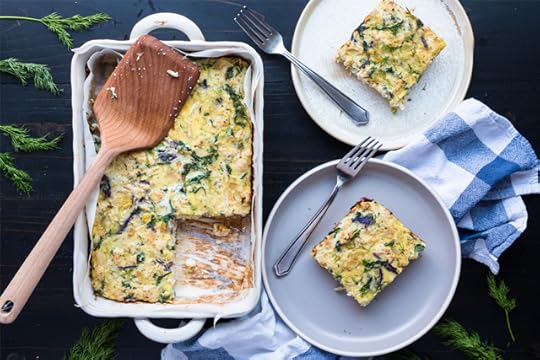
Nutrition Information per serving (? of egg bake, assuming ground chicken is used):
Calories: 283
Total Carbs: 7 grams
Net Carbs: 4 grams
Fat: 19 grams
Protein: 24 grams
The post Keto Egg Bake appeared first on Mark's Daily Apple.



January 17, 2020
Weekly Link Love – Edition 64

Research of the Week
The environmental footprint of different diets is not what we’ve been led to believe.
Genetic analysis of ancient Hungarian conquerors.
Men on a low-fat diet may have lower testosterone.
Glucose metabolism takes center stage in Alzheimer’s.
New Primal Blueprint Podcasts
Episode 399: Kate Cretsinger: Host Elle Russ chats with Kate Cretsinger, who after defeating her own serious health problems through nutrition, became a coach, helping others do the same.
Primal Health Coach Radio, Episode 43: Laura and Erin chat with Anna Fruehling, a practicing health coach living in Grand Island, Nebraska. In her small town, local physicians refer patients with metabolic syndrome to Fruehling because of her unique approach.
Each week, select Mark’s Daily Apple blog posts are prepared as Primal Blueprint Podcasts. Need to catch up on reading, but don’t have the time? Prefer to listen to articles while on the go? Check out the new blog post podcasts below, and subscribe to the Primal Blueprint Podcast here so you never miss an episode.
Media, Schmedia
What are the consequences of constantly eating microplastics?
Turns out that many common medications affect our brains, and even our personalities.
Interesting Blog Posts
Remember all those researchers who rushed to criticize studies that suggested red meat probably doesn’t cause heart disease and cancer? Turns out they have strong financial ties to the plant-based industry.
Social Notes
Watch me make deviled eggs.
Everything Else
Did Thoreau’s diet do him in?
Dr. Oz on breakfast: a “ploy” that we should “cancel.”
Is carb loading necessary for an athlete? How one type 1 diabetes athlete manages to avoid it.
Things I’m Up to and Interested In
Funny how that works: Human brains got bigger right before the (delicious) megafauna started disappearing.
Article I found interesting: The people trying to save scents from extinction.
Bad for you, bad for the environment: Obesity.
I know people like this: Addicted to exercise.
Unintended consequences: Brazil wanted to get rid of daylight savings time. Now they miss it.
Question I’m Asking
Should cell phones be outlawed for anyone under 21?
Recipe Corner
Chimichurri: not just for steak.
Shrimp in garlic sauce (rice optional).
Time Capsule
One year ago (Jan 11– Jan 17)
Keto for Men: 6 Tips to Optimize Your Results – Essential tips for any man.
Dear Mark: How Do Fermented Food and Meat Interact? – Do they have a special, synergistic relationship?
Comment of the Week
“‘C’mon, people. The experts have spoken. Isn’t it about time you stopped with the keto nonsense?’
Um no.”
– Exactly, Angelica.

The post Weekly Link Love – Edition 64 appeared first on Mark's Daily Apple.



January 16, 2020
Intermittent Fasting: How It Works, Reasons to Try It & Considerations for Athletes
 It’s curious how not eating can spark so many questions and debates. A practice born out of necessity for our ancestors, fasting for long stretches happened when weather or circumstance hampered hunting and gathering, or for shorter periods while on the hunt or foraging.
It’s curious how not eating can spark so many questions and debates. A practice born out of necessity for our ancestors, fasting for long stretches happened when weather or circumstance hampered hunting and gathering, or for shorter periods while on the hunt or foraging.
As food has become readily available and abundant in many countries, our near-constant state of food arousal can dull the hormonal drivers that regulate appetite and, ironically, lead us to want to counteract the overabundance with some restriction. When we eat too much too often, we get the natural inclination to push back from the table and vow not to consume another bite for a (possibly long) while.
Fasting, particularly intermittent fasting, is gaining popularity now as a weight loss and weight management tool. As some celebrities proclaim that intermittent fasting is one of their “secrets” to their hard Hollywood-worthy bods, more and more people will be keen to latch on. We compiled a list of our greatest hits on fasting and intermittent fasting to provide education and context around how intermittent fasting works, reasons you may want to try it, reasons you may not want to try it, and considerations for athletes who want to fast.
First, let’s start with the basics. Before making any changes to your eating (or non-eating) habits, it’s important to understand:
what it means to fast
why people fast
how long to fast
what benefits or downfalls there could be to fasting
whether all of the above can or should apply to you individually
Do the effects of fasting differ for men and women? What are the most common things people get wrong about fasting? Is fasting an effective tool for weight loss? We answer those questions, and more, in the following articles.
Fasting How to

How to Lose Weight with Intermittent Fasting
Fasting can be really beneficial to those who are trying to lose fat. Yes, that’s fat and not weight. Unlike some other kinds of weight-loss methods, which result in loss of water weight or muscle mass, fasting can effectively get rid of fat.
How to: Intermittent Fasting
There is no one way to do IF. The only real guideline is that, as always, the food you eat should be healthy. (It’s pretty clear how we choose to characterize that.) In addition to the substantial health benefits, the simplicity and flexibility are what draw people to IF.
Dry Fasting
Dry fasting is going without both food and fluid. That means no coffee, no tea, no broth, and no water or liquid of any kind (except the saliva you manage to produce). It’s an extreme type of fast whose fans and practitioners are adamant that it can resolve serious health issues. But does it? Is it safe? And what kind of research is available on it?
Fasting vs. Carb Restriction
Both fasting and carb-restriction appear to operate along similar physiological pathways. Both lower carbs. Both increase fat-adaptation. Both have the potential to get you into ketosis. Both lower insulin and blood sugar. But is one better than the other?
Top 10 Fasting Mistakes
If you’re making fasting mistakes, you might never accomplish the benefits you were hoping for. Before you throw in the towel, I want to help you identify some possible fasting pitfalls you might not be aware of and also help you avoid them.
The Pros and Cons of Fasting

The Health Benefits of Intermittent Fasting
Fasting is one way to have your cake and eat it too. Beyond the already proven benefits of a Primal Blueprint low-carb lifestyle, fasting once in a while seems to offer many of the same benefits of calorie restriction—you know, stuff like increased longevity, neuroprotection, increased insulin sensitivity, stronger resistance to stress, some cool effects on endogenous hormone production, increased mental clarity, plus more—but without the active, agonizing restriction.
Intermittent Fasting for Women
With fasting, perhaps the most important variable to consider is your biological sex. This really does make intuitive sense. Biology cares most about your fertility. Can you reproduce? Can you produce healthy offspring that survive to do the same? These things come first. And from that perspective, a woman’s situation is more precarious than a man’s.
Should You Try Fasting?
Primal folks who are losing weight or looking to lose a bit more, and getting the right lifestyle changes enacted (sleep, exercise, sex, leisure, rest, relaxation, mental stimulation) should definitely try fasting. They will likely flourish.
When Does Fasting Cross the Line?
How do you know if your fasting regimen may be slipping into the grey area of potential orthorexia or disordered eating? We can’t diagnose anyone in an article, of course, but there are signs to watch out for if you have personal concerns or worries about others.
14 Reasons to Fast
Anytime you attempt a “radical” health practice like not eating, it helps to have a good reason to do it. That will not only give you something to aim for, but it will ensure you actually have a physiological justification for your experiment. Never go in blind. What are some of the specific scenarios and conditions where fasting makes the most sense?
Long Fasts: Worth the Risk?
If fasting for more than three days sounds riskier than just skipping breakfast, you’re right. Long fasts can get you into trouble. They’re a big commitment. You shouldn’t just stumble into one because it sounds interesting or some guy on your Twitter feed wrote about it.
What Breaks a Fast?

It’s the nature of many beings—particularly those with weight-loss goals, it seems—to want to know what the “rules” are so they can look for the loopholes to bend them. It’s no surprise that the top-performing article last year on Mark’s Daily Apple was “Does Coffee Break a Fast?” Consequently, we followed up with an article about whether bone broth breaks a fast because we received additional questions. Then people wanted to know about supplements—should they be taken while fasting? We then created a definitive guide to what breaks a fast. If there’s any other liquid, leaf, pill, stone, or twig we neglected to examine, let us know in the comments section.
Does Bone Broth Break a Fast?
Most people aren’t fasting to be able to brag about eating no calories for X number of days. They fast for shorter (often intermittent) periods of time for specific health benefits. It’s entirely possible that bone broth “breaks a fast” but allows many of the benefits we associate with fasting to occur.
Does Coffee Break a Fast?
Does black coffee break a fast? Put another way… Does coffee interfere with the benefits we’re seeking from a fast? Depends on the benefits you’re seeking (and what you put in the coffee).
Let’s look at some of the most common benefits first and if/how coffee affects them.
Do Supplements Break a Fast?
Does fish oil break a fast? What about my multivitamin, protein powder, collagen, or melatonin? Mark delves into the research to provide definitive answers.
Definitive Guide to What Breaks a Fast
One of the most common questions I get is “Does [x] break a fast?”
What they’re really inquiring about is: “Does this interfere with, negate, or nullify the benefits of fasting?” Let’s go through the most popular queries one by one and figure out how each one affects an intermittent fast.
Does Intermittent Fasting Work for Athletes?

Does fasting before and during workouts confer any performance perks or additional fat-burning benefits? Should athletes fast before every session, or only specific types of workouts? What are the potential drawbacks to fasting for athletes? Let’s go.
Intermittent Fasting Tips for Athletes
What are my specific recommendations for athletes who wish to explore intermittent fasting? I’ve got 12… plus some details about my own fasting and workout routine.
Benefits & Concerns Fasting for Athletes
Sometimes, high stress is exactly what we need to progress—a few heavy sets of squats, some rounds on the Airdyne, a killer CrossFit workout—as long as you can recover from it. A major modulator of our stress is the amount of food we have coming in. At least in theory, exercising in a fasted state could provoke a powerful adaptive response that athletes would find helpful. So, does it stack up? What exactly can intermittent fasting offer athletes?
Fasted Workouts
To some, the idea of working out without “carbing up” or doing the pre-workout protein shake is unthinkable. To others, fasted workouts are sacred tools, the perfect antidote to modern decrepitude. Where does the truth lie?
That’s it for today, folks. Thanks for reading, take care, and leave a comment below if there are more questions you have about IF!
The post Intermittent Fasting: How It Works, Reasons to Try It & Considerations for Athletes appeared first on Mark's Daily Apple.



Mark Sisson's Blog
- Mark Sisson's profile
- 199 followers














